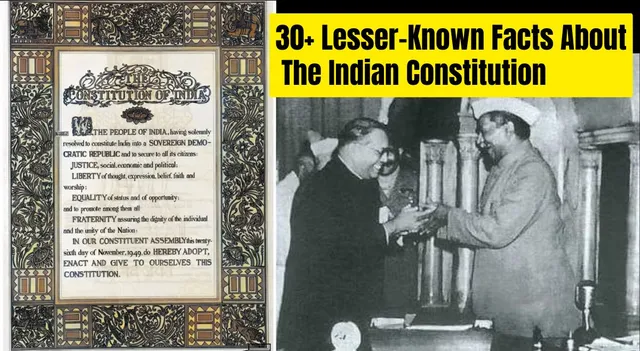- By Ridam Sharma
- Wed, 26 Nov 2025 12:43 PM (IST)
- Source:JND
Lesser-Known Facts About The Indian Constitution: Constitution Day of India is also known as the National Law Day or even ‘Samvidhan Diwas.’ The day is all about honouring India’s long and descriptive constitution, which serves each citizen of the secular nation of billions. The constitution of India was adopted on November 26th 1949, which came into effect on January 26, 1950, almost two months later. The Indian Constitution is world-famous for being a blend of both democratic and secular state features, along with a main motto of strong protection for each of its citizens, without any bias. To learn more about the Constitution of India, here is a list of more than 30 unique and lesser-known facts about it.
List Of 30+ Unique And Lesser-Known Facts About India’s Constitution For Constitution Day Of India 2025:
1. The formal beginning of the process to draft India's Constitution took place on 9 December 1946, which was way before the formal declaration of Indian independence on August 15th, 1947.
2. The Constitution of India was adopted on 26 November 1949, but actually came into force on 26 January 1950.
3. The framing of the Constitution took about 2 years, 11 months and 18 days, with hundreds of sittings, debates and committee reports feeding into the final text.
4. The Government of India Act, 1935, provided a large structural blueprint, along with many provisions that were retained and modified in the constitution, rather than written from scratch.
5. To your surprise, the original Constitution of India is wholly handwritten in both English and Hindi. Not a single page of the original Indian constitution was printed or typed.
6. Calligrapher Prem Behari Narain Raizada wrote the entire English version of the Indian Constitution by hand in a flowing italic style.
7. Later, each page of the Indian constitution was illustrated by artists from Shantiniketan under the guidance of Nandalal Bose.
8. The original copies are preserved in special helium-filled cases in the Parliament Library to protect the delicate handmade paper and ink.
9. Dr Bhimrao Ramji Ambedkar is celebrated as the ‘Father of the Indian Constitution.’ However, the key constitutional adviser was Sir BN Rau, who was responsible for preparing the initial draft of the Constitution of India.

10. SN Mukherjee served as the chief draftsman who translated the Assembly’s decisions into precise constitutional language.
11. The Constituent Assembly adopted the elephant as its official seal, and this is a sign of the power, the wisdom and the patience in the nation-building process.
12. India possesses one of the longest written constitutions on Earth that initially had 395 Articles and 8 Schedules.
13. The Constitution has, over the years, grown to approximately 470 Articles contained in 25 Parts and 12 Schedules and various appendices.
14. Although so long and elaborate, the Constitution of India is intended to be both inflexible and flexible in parts: some of the provisions of the Constitution may be amended by a simple majority, others by special majorities and by ratification by the state.
Recommended For You
15. So far, over 100 constitutional changes have been enacted that have constantly changed and defined the original writing.
16. The Constitution establishes a quasi-federal system, and that is why it appears federal, and at the same time, the Constitution possesses robust unitary characteristics like a strong Union government and unified citizenship.
17. India, unlike most federations, does not have individual state citizenship, but just one citizenship for the entire nation.
18. The Parliament, by law, may rearrange the state boundaries through the Union without a formal amendment to the Constitution itself.
19. The drafting of the Fundamental Rights was influenced by many other foreign constitutions and international charters, yet it was made in accordance with the social realities in India.
20. The Irish-inspired Directive Principles of State Policy are not justiciable guidelines that attempt to steer governments towards social and economic justice.
21. Basic responsibilities were not included in the original piece, added by the 42nd Amendment of 1976 at the time of the Emergency.
22. The Basic Structure doctrine developed out of the Kesavananda Bharati case of 1973, constrains the power of Parliament over the amendment of the basic features such as democracy, secularism and judicial review.
Also Read: National Constitution Day 2025 Quiz: Top 10 Quizzes With Answers About Samvidhan Diwas
23. The 42nd Amendment is sometimes referred to as the Mini-Constitution in that it brought drastically far-reaching changes in a single move. This amendment added the words socialist and the word secular in the Preamble and the word integrity to the phrase unity of the Nation.
24. The 44th Amendment revoked some of the emergency era provisions and enhanced greater protection of civil liberties.
When Dr. Ambedkar handed over the Constitution of India to President Rajendra Prasad on 26 November 1949, the words “secular” & “socialist” were not present anywhere in it. These terms were added later. At that time, it described India simply as a “Sovereign Democratic Republic.” pic.twitter.com/gJI990o0ZQ
— The Dalit Voice (@ambedkariteIND) November 26, 2025
25. The asymmetry in arrangements and additional protections to some states and regions was especially meant to be granted on special articles like articles 370 and 371, citing the diversity of India. These arrangements included a separate state flag and a Constitution in Jammu and Kashmir; those provisions have been modified by subsequent legislation.
26. The Fifth and Sixth Schedules will offer special administrative and autonomy models to tribal and scheduled territories, particularly the Northeast.
27. The very beginning saw the introduction of universal adult franchise, one person one vote, a radical step in a new independent, and mostly illiterate nation.
28. The long, protracted struggles over suffrage that had befallen many other western nations were not experienced in India as the Constitution was enforced in 1950, and Indian women were given the right to vote throughout the nation.
29. The Election Commission of India is a constitutional authority, and it was supposed to act as an independent referee to ensure that political competition is fair.
30. Several boards which individuals believe to be entirely statutory, like the Finance Commission and Public Service Commissions, have express constitutional status and protection.
#ConstitutionDay greetings to all my fellow citizens. Today, we commemorate the adoption of the Constitution of India and renew our pledge to uphold the values enshrined in it. We honour the framers of our Constitution, especially its chief architect, Dr. B.R. Ambedkar Ji, for… pic.twitter.com/cLkNAzReLU
— N Chandrababu Naidu (@ncbn) November 26, 2025
31. Regarding the official language of the Union, the Constitution acknowledges Hindi in the Devanagari script, but not a national language. The text of the authority is in English, which is necessary legally and in Parliament. Despite this, Hindi and other translations are also widespread.
32. Before the Constitution Day 2025, new official translations are being published in several Indian languages, like Malayalam, Marathi, Nepali, Punjabi, Bodo, Kashmiri, Telugu, Odia and Assamese.
33. The Preamble was also read in solemnity during the first session of the Constituent Assembly as some sort of moral and political guide to the Republic.
34. The Ashoka Lion Capital, the emblem of India, receives a constitutional status, and there are strict regulations on its use and representation.
Each of the above-mentioned facts about the Indian Constitution highlights its significance in the life of a nation of billions. India is a country of diversity, known as a global secular power, and its constitution is designed to serve the needs of its citizens, the world's largest population. These 30+ unique and lesser-known facts about the Indian Constitution are perfect to know its significance, history of making and much more about the national pride.




-1764244902024_m.webp)

